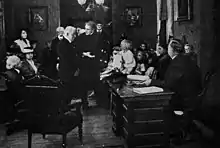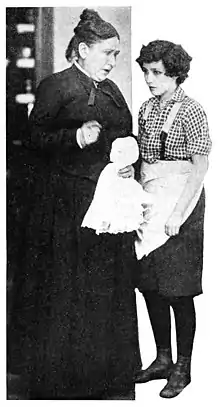Cheerful Givers
Cheerful Givers is a 1917 American silent comedy-drama film produced by the Fine Arts Film Company and distributed by Triangle Film Corporation.[1] The film stars Bessie Love and Kenneth Harlan.[5]
| Cheerful Givers | |
|---|---|
 Newspaper advertisement | |
| Directed by | Paul Powell |
| Written by | Mary H. O'Connor[1] |
| Starring | Bessie Love Kenneth Harlan |
| Cinematography | John W. Leezer[2] |
Production company | |
| Distributed by | Triangle Film Corporation |
Release date |
|
Running time | 5 reels[4] |
| Country | United States |
| Language | Silent (English intertitles) |
The film is presumed lost.
Plot

In order to save her father's orphanage, Judy (Love) answers a request to have the "eldest boy" work in the kitchen of a rich, miserly woman. She disguises herself as a boy, and, there, she crosses paths with the woman's son Horace (Harlan), whom she mistrusts, but who realizes that she is a girl and who falls in love with her. Judy thwarts the son's plans to steal from his mother's safe. The son realizes his error, and Judy falls in love with him.[3][6][7][8][9]
Cast

- Bessie Love as Judy
- Kenneth Harlan as Horace Gray
- Josephine Crowell as Mrs. Harriet Gray
- Spottiswoode Aitken as Rev. John Deady
- Bessie Buskirk as Lizzie Vance
- Pauline Starke as Abigail Deady
- Winifred Westover as Estella
- Loyola O'Connor as Mrs. Parker
- William H. Brown as Bob, Factotum of Orphanage
- Violet Radcliffe as Orphan
- Beulah Burns as Orphan
- George Stone as Orphan
- 'Baby' Carmen De Rue as Orphan
- Francis Carpenter as Orphan
- Ninon Fovieri as Orphan
- Lloyd Perl as Orphan
- Violet Wilkey as Oldest Orphan Girl (uncredited)[3][6]
Reception
The film was generally well-received, called an "adroit comedy" and "perfectly done",[10] and it had a wide appeal.[11][12][13][14] Some reviewers deemed the film "too slow."[15]
It was noted that, although her performance was strong,[16] Bessie Love was not yet fully a box office draw throughout the country.[17][18]
References
- "Varying Themes in Four Triangle Presentations". Motion Picture News. Vol. 15, no. 15. p. 2332.
- Love, Bessie (1977). From Hollywood with Love: An Autobiography of Bessie Love. London: Elm Tree Books. p. 149. OCLC 734075937.
- L.H. (April 21, 1917). "Films Reviewed". The Billboard. p. 60.
- Kansas State Board of Review (1917). Complete List of Motion Picture Films. p. 14.
- Hanson, Patricia King, ed. (1988). The American Film Institute Catalog of Motion Pictures Produced in the United States: Feature Films 1911–1920. Berkeley, California: University of California Press. p. 101. ISBN 978-0-520-06301-3.
- Milne, Peter (April 28, 1917). "Screen Examinations". Motion Picture News. Vol. 15, no. 17. p. 2690.
- "Pictures and Everything That Appertains Thereto". The Billboard. April 7, 1917. p. 62.
- Essex, Bert D. (May 1917). "The Silent Trend". The Photo-Play Journal. Vol. 2, no. 1. p. 26.
- Horak, Laura (February 26, 2016). Girls Will Be Boys: Cross-Dressed Women, Lesbians, and American Cinema, 1908–1934. Rutgers University Press. ISBN 978-0-8135-7484-4.
- Johnson, Julian (July 1917). "The Shadow Stage". Photoplay Magazine. Vol. 12, no. 2. pp. 86–87.
- Whitman, M.H. (September 15, 1917). "What the Picture Did for Me". Motography. Vol. 18, no. 11. p. 542.
- Manley, P.F. (September 29, 1917). "What the Picture Did for Me". Motography. Vol. 18, no. 13. p. 643.
- Trinz, S. (May 5, 1917). "What the Picture Did for Me". Motography. Vol. 17, no. 18. p. 920.
- Trinz, Edward (May 19, 1917). "What the Picture Did for Me". Motography. Vol. 17, no. 20. p. 1028.
- Miles, A.N. (March 9, 1918). "What the Picture Did for Me". Motography. Vol. 19, no. 10. p. 450.
- "At the Oak Park Theater". Forest Leaves. Vol. 11, no. 16. April 20, 1917. p. 4.
- Guthrie, George B. (July 14, 1917). "What the Picture Did for Me". Motography. Vol. 18, no. 2. p. 61.
- Miller, Harry (May 12, 1917). "What the Picture Did for Me". Motography. Vol. 17, no. 19. p. 977.
External links
- Cheerful Givers at IMDb
- Cheerful Givers at AllMovie
- Cheerful Givers at the American Film Institute Catalog
- Cheerful Givers at the British Film Institute
- Lobby poster